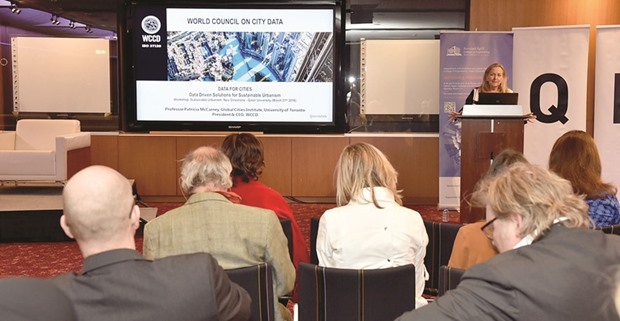
Speakers and participants, after the end of the event, at the Urban Forest created by Al Nakheel Landscapes in QNCC.
This was the simple premise that powered an enlightening workshop titled ‘Sustainable Urbanism, New Directions’ at the Qatar National Convention Centre on Monday.
Organised by Department of Architecture and Urban Planning, College of Engineering, Qatar University (QU), the gathering featured a great variety of speakers – international researchers, academics, and professionals – and has somewhere helped create international networks for research projects and has also brought new knowledge to Qatar.

Dr Anna Grichting Solder, Assistant Professor, Department of Architecture and Urban Planning, at Qatar University, College of Engineering, at the event.
The presence of such a robust array of voices along with students helped create a space “to share knowledge, to provide a fertile ground for future research, and to identify new directions, new fields, new topics that research in social sciences can or should take,” believes Dr Anna Grichting Solder, Assistant Professor, Department of Architecture and Urban Planning, at Qatar University, College of Engineering.
In her speech, Grichting, who is one of the main organisers of the event, elaborated on the significance of the subject of the workshop. “The aim of this workshop is to discuss new directions in the sustainable urbanism in the social sciences. Architecture and Urbanism are between disciplines, across disciplines. Being in the border is what contemporary philosophy describes as the spaces where most creative things happen,” she said.
Throughout the workshop, the experts explained how new paradigms for sustainable urbanism are emerging and will play a key role in the health of the city and the planet, including urban biodiversity, food urbanism, water-sensitive urban design, systems thinking in urban planning, ecological urbanism, etc.
“While much knowledge, tools and technologies have been created to construct sustainable cities, in many cases we are still lacking a holistic and integrated approach to urban design that includes all biological species, human communities, urban systems – transportation, water, solid waste, air quality,” said a note on the workshop’s objectives.
Education and awareness are important factors to contribute to these objectives, and it is important to engage students in the workshop and discussions, Grichting pointed out. “I would like to thank Qatar National Research Fund for making this workshop possible and to Qatar University for their support. I am also deeply grateful to The Swiss Embassy in Qatar for hosting the dinner reception, to Al Nakheel for the beautiful urban forest landscape they have created for us, and to Al Sulaiteen for their support of our permaculture and Soul to Soil workshop. And of course to all the people who have helped to make this happen,” she said at the outset, adding that Dr David Reksulak and Dr Julia Lane helped her conceptualise and organise the workshop.
Of the three topics up for discussion, the first was Sustainable Urbanism: New Paradigms which dealt with new approaches to physical planning of the built environment, in particular ones that integrate landscape, ecology and urban planning, as well as urban design that considers the city as a system. The second topic was Sustainable Urbanism and the Social Sciences which focused on people and communities in the city, and their role in the sustainability of a healthy, safe and liveable city. The third topic was about Urban Data and Urban Indicators for Sustainability.
When asked about why a holistic sustainable urbanism approach is the way ahead for Qatar, Grichting told Community, “It is imperative that we work with, and not against nature in shaping our cities and environments. It is important to approach sustainability in urbanism not just from a technological point of view, but also from the social sciences. It is people’s behaviour, the structures of society, the values of culture and environment that, too, shape a city’s sustainability.”
Grichting pointed out that this requires a shift in the conceptualisation of urban plans, and ones that begin with natural systems and integrate technological solutions, with the aim to give back to nature and to the biosphere. “Smart cities are often designed and discussed from a technological point of view, they propose efficient systems to build and operate a city. Yet they often overlook the communities that live in the urban areas, which should include both human and natural species – flora and fauna. Planning also begins with people and we are witnessing the co-creation of urban projects by communities, NGOs, planners, and authorities. A healthy city requires healthy populations and communities – both in physical and mental health. Areas of research that address people and species are emerging through interdisciplinary research and practices,” she said.
Meanwhile, as part of the Sustainable Urbanism event, there was also a permaculture workshop called Soul to Soil at QU on Saturday. “As urbanists we often look at the ground as a flat surface – whereas the ground is made of soil – which has many layers and living organisms which are essential to our well-being and that of the planet. Everything we ingest in our bodies comes from the soil and is affected by the quality of the soil,” Grichting explained, “Also, the soil workshop is important as we need to reconnect to the ground and the soil as a precious and living substance, not merely as a real estate value.”
The workshop leader, Nance Klehm, seeks to engage communities to reclaim and produce their soil by recycling all their organic and inorganic materials to create fertile compost to grow food and plants.
“By understanding how the soil is made and how organisms and minerals interact, people are more attached and engaged to the soil. Additionally, we had a students’ session on Blue Planet Design which looks at urban design related to water and to the oceans. Both soil and water are essential elements to consider in urban design and transformations can be brought about through design and technology, but also through community engagement, education, and empowerment.”



